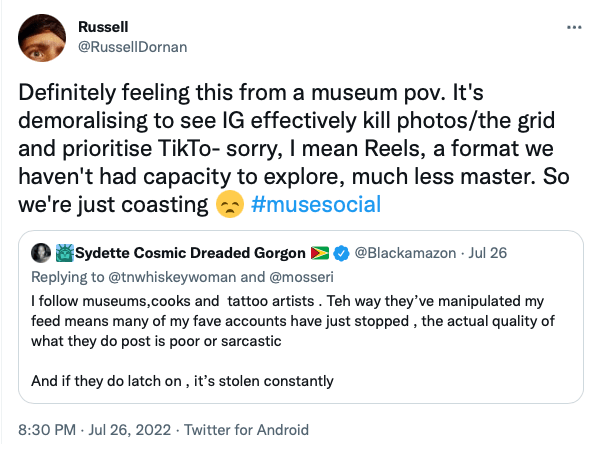Insurrection at Instagram: from Social Media to Recommendation Media
Content is King, they say. In today’s world of social media, the King is video, but what problems is that causing for the platforms and content creators?
For the past decade, the museums world has been exploring the merits of Instagram, the extremely popular photo-sharing site. Over the years, museums have engaged with users of the platform, often with great success, and it can be argued that Instagram has changed the way audiences behave in museum spaces and changed the way museums see and present themselves.
In a sense, Instagram levelled the playing field for small cultural heritage venues to be as popular as the big boys. Instagram became a place where, despite the British Museum having 2 million followers, it was the Museum for English Rural Life that made the big splash back in 2018 with its ‘Absolute Unit’. With wry, pithy observations connected to images from its collections, MERL grabbed the attention of millions of viewers, even Elon Musk.
As Instagram’s popularity has risen, museums have scrambled to make themselves more ‘Instagrammable’, with galleries set up to provide easy inspiration for visitors to take selfies with iconic objects.
You’d think that the rise of rival channels, like Tik Tok, would only increase the appetite of museums to go viral. Indeed The Black Country Living Museum has made a real splash on Tik Tok, but the advent of video content as a quick, easily consumable bite is causing museums social media managers quite the headache, it appears.
In an effort to combat the popularity of Tik Tok, Instagram have prioritised content rather than connection in the feeds to their users, while introducing Reels – a new way to show off video content. Users now see recommended content in their feeds, which is a big change to seeing the content created by those you follow. As Michael Mignano argues, in some ways, this approach is sensible…
‘And yet, these shifts towards algorithmic feeds over friend feeds make sense. Platforms like the massively popular (and still growing) TikTok and YouTube put far less emphasis on friends and social graphs in favor of carefully curated, magical algorithmic experiences that match the perfect content for the right people at the exact right time. This is recommendation media, and it’s the new standard for content distribution on the internet.’
Not all users and content creators agree. Kylie Jenner, an Instagram titan with over 360 million followers complained, ‘Make Instagram Instagram again. Stop trying to be TikTok. I just want to see cute photos of my friends. Sincerely, everyone.’
Instagram’s CEO, Adam Mosseri, posted his own response to Jenner’s complaint, arguing,
‘I want to be clear. We’re going to continue to support photos… it’s part of our heritage. That said, I need to be honest. I do believe that more and more of Instagram is going to become video over time. We see this even if we change nothing. We see this even if you just look at chronological feed.’
So where does this leave the cultural sector? Social Media is hugely significant to museums for engaging with their audiences, especially so since the pandemic. With this shift by the platforms to Recommendation Media (as it is being called), the digital managers at our cultural organisations will have to adapt to survive. Making engaging content, regardless of how it is chosen to be shared (via users hitting a like or reshare button, or via an algorithm selecting it as relevant content), remains a difficult endeavour, but it seems that content creators will have to get even more attuned to the trends and memes that the post-millennial generations will want to see and consume. Are we ready for this? Time will tell.




